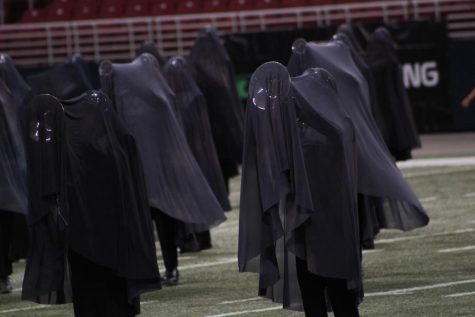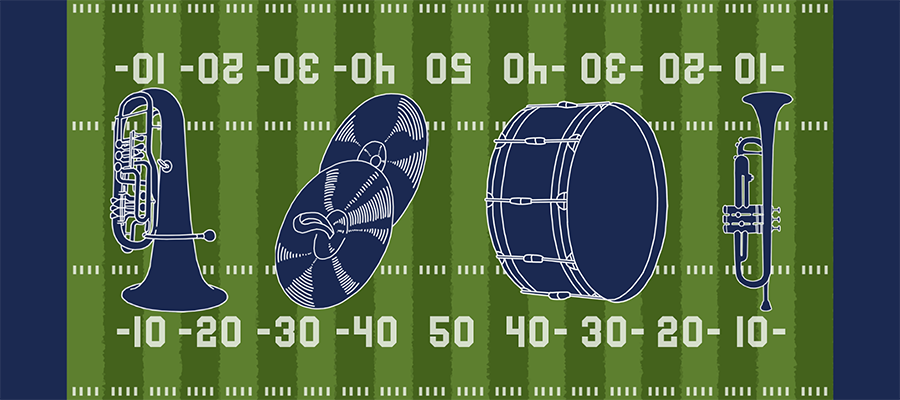Competitive, athletic nature of marching falling under sport definition
February 21, 2020
A marcher runs exactly in time, heart racing from adrenaline, arms burning from the weight of the horn, sweat running under multiple layers of uniform, lungs emptying on the musical impact.
The marcher’s athleticism is part of a competition entertaining a full stadium. This makes marching band, by definition, a sport.
There is no doubt the activity is athletic. At Coppell High School, band students receive 0.5 physical education credits during the fall semester, and for good reason.
Every summer, students rehearse in scorching heat for hours on end, and marching a full, eight to nine minute show is no small feat. Marching is much more difficult than simply walking. It requires technique, precision and posture, all while holding still an instrument weighing up to 40 pounds.
Visuals alone are physically challenging, but a large part of what makes marching band so difficult is playing at the same time.
Turn on any sports channel to see athletes panting, taking in as much air as possible, as the body uses oxygen for energy. Marching band members cannot do the same and must have consistent airflow to play their instrument, depriving them the same amount of energy other athletes have available to them.
“You’re moving around while trying to keep your air still, which is a challenge by itself,” CHS associate director of bands Adrian Caswell said. “The amount of air you have to use is constant, and you never really get to take a break.”
In addition to marching and playing, marching band has other visual effects, including lunging and jazz running, which require specific techniques that make them nothing like day-to-day physicalities.
Furthermore, marching bands include color guards, performers who spin flags, rifles and sabers to add to the show’s visual aspect.

The Coppell High School varsity marching band performs its 2019 marching show, “Nouveau Réalisme”, at the Bands of America St. Louis Super Regional on Oct. 19. The Sidekick staff writer Angela Yuan thinks marching band is a sport because of its athleticism and competition. Photo courtesy HornRank
“A lot of [guard] members [toss rifles] six rotations in the air,” CHS color guard member Anusha Kakileti said. “It takes a lot of strength and understanding of the push-lift motion [of tossing props]. You have to be able to focus on where the wind is coming from and what you have to do to [account for its effect on props].”
Guard members are especially susceptible to sports injuries, which range from bruises to wrist pain.
Even more athletic than marching band is drum corps, professional marching ensembles of about 150 members.
Where marching bands have woodwind instruments, drum corps wind sections are all brass. Maintaining correct posture while holding brass instruments up at an angle is especially challenging.
Drum corps make up for a lack of members with their shows – drum corps shows are generally longer and more difficult than marching band shows. An ESPN feature monitored the heart rate of a quads drums player, who had a heart rate comparable to that of a marathon runner.
Drum corps in the United States and Canada participate in Drum Corps International (DCI) competitions. The competitive nature of drum corps aligns with the dictionary definition of the word sport.
A common counterargument against marching band as a sport is it is not inherently competitive, as it does not necessarily involve competition.
However, Bands of America (BOA), which hosts high school marching contests; Winter Guard International (WGI), which hosts indoor color guard contests; and DCI share similarities with professional sports leagues.
Like professional sports league games, competitions are hosted in sports arenas and broadcasted on sports networks, while garnering large live crowds through ticket sales. Marching shows are scored, and ensembles are divided into classes based on size and other factors.
Another counterargument states marching band is too artistic to be a sport. Art and sports have many intersections, and many other competitive, athletic artistic activities, such as gymnastics or ice skating, are considered sports. Marching shows tell a story, but they also compete for victory.
“There’s just so many facets that go into the same thing. It’s cool to be putting it all together,” Caswell said.
Follow Angela (@anglealey) and @SidekickSports on Twitter.
